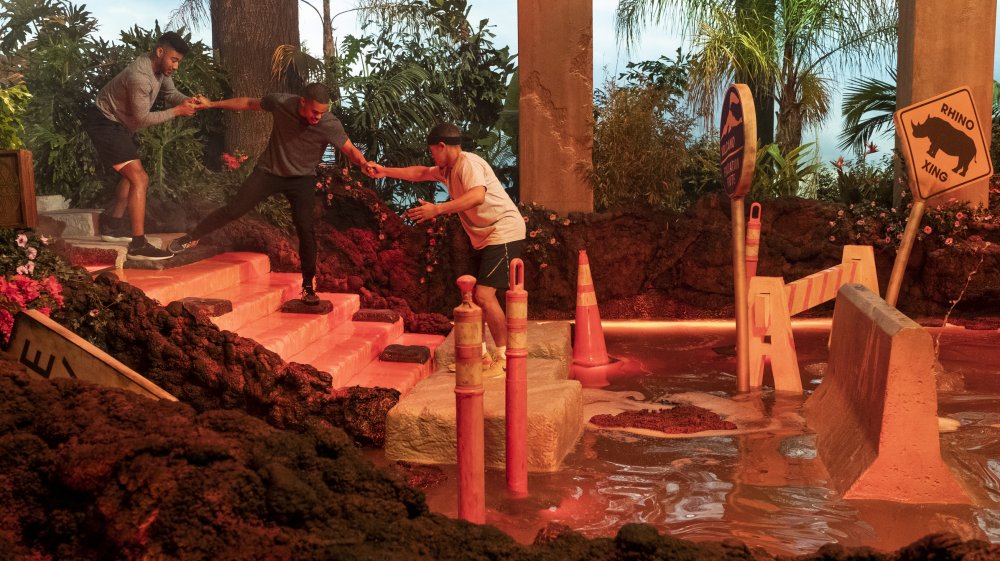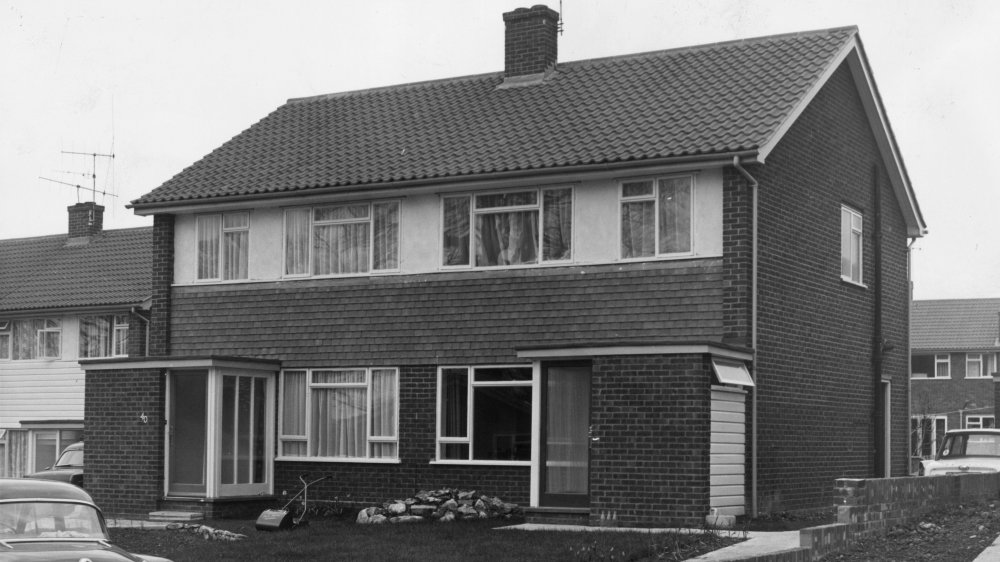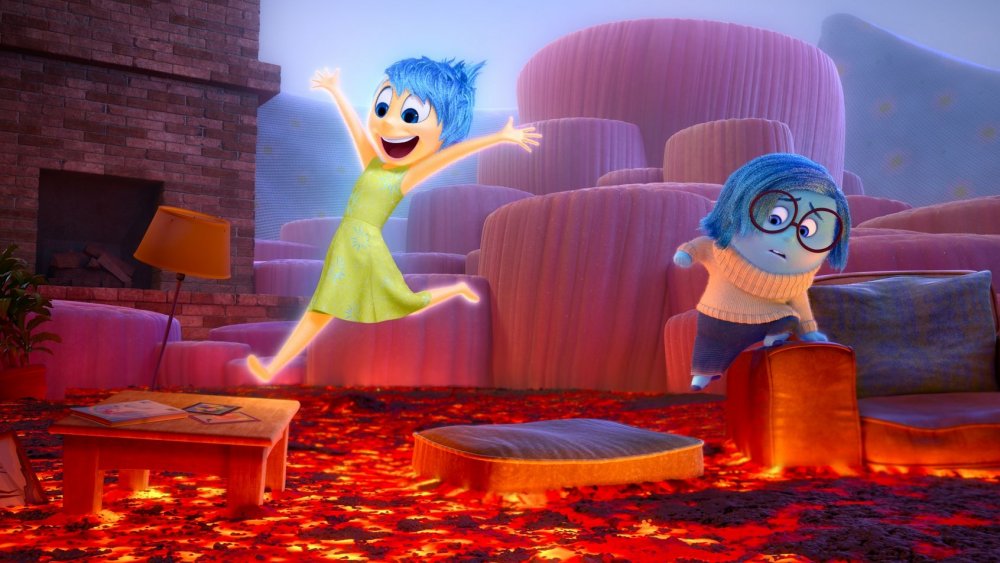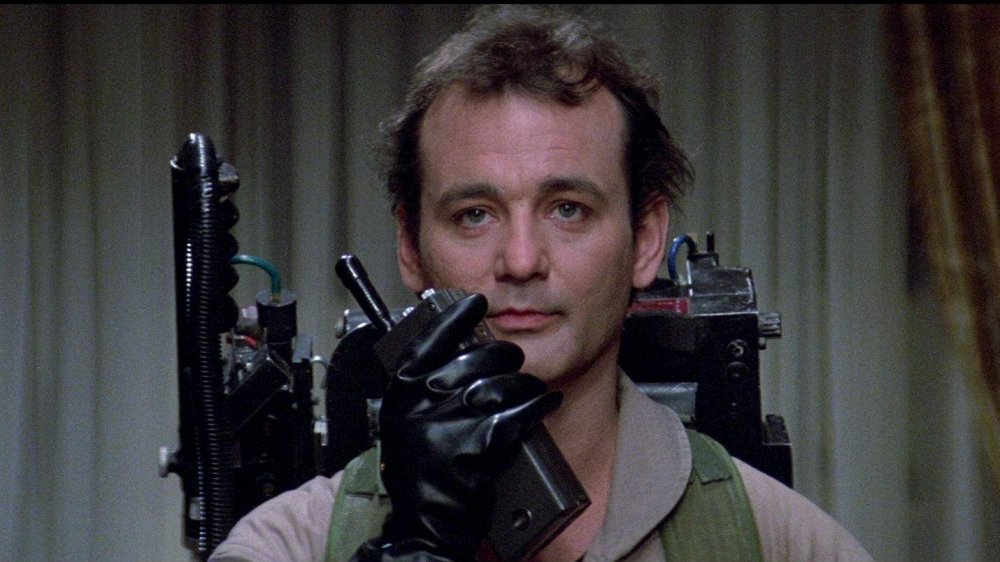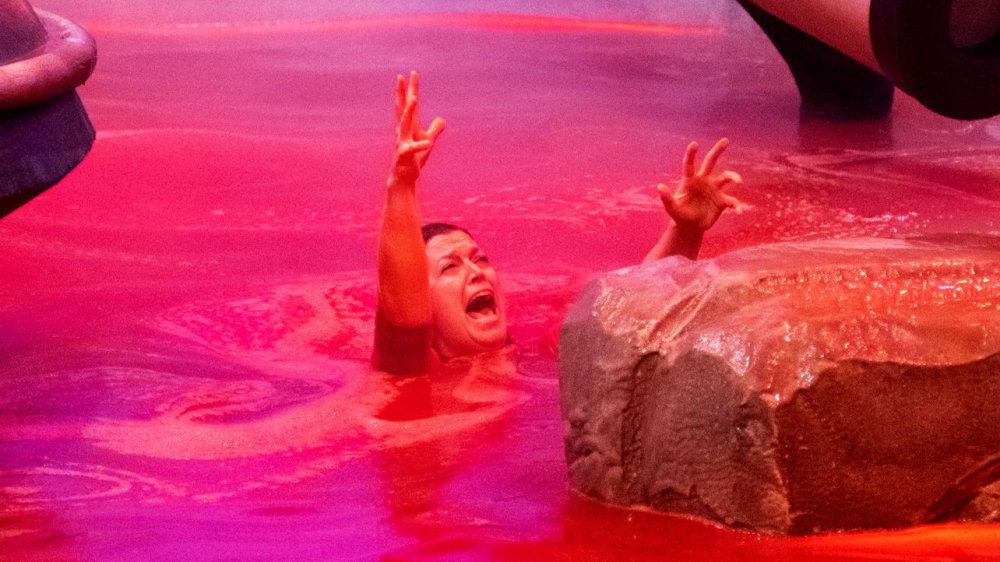The Untold Truth Of Floor Is Lava On Netflix
Floor Is Lava is a competitive game show streaming on Netflix that draws inspiration from the children's game of the same name. And while there are plenty of things to watch on Netflix, Floor Is Lava has taken the streaming service by storm.
You could write off the success of a show where people have to hop around complex obstacle courses for prizes and bragging rights as being a fluke success. You might simply say that the novel coronavirus keeping people cooped up in their homes has got everybody so bored that they'll watch anything. But here's the question — why Floor Is Lava specifically? There's no shortage of TV options out there to serve as distraction, so why are so many people suddenly watching this particular contemporary take on a classic children's game?
Sure, lots of parents have kids stuck in the house in need of something to do, but the untold truth of Floor Is Lava's success is rooted in layers of nostalgia that run deeper than the very lava itself.
The origins of Floor Is Lava
There was a time when the there was no such game as "The Floor Is Lava." There was a time when the floor was not lava at all. So, how did the floor get so hot?
Director of the Harvard-MIT Ethics and Governance of AI Initiative, Tim Hwang, authored a paper in 2018 called "On the Architecture of the Folk Game: The Case of 'The Floor Is Lava," theorizing that the game came into being as a direct result of the rise of the living room as common space in the American suburban home.
From the 1930s forward, the living room took up more and more space as the average size of the suburban home grew — and it grew, specifically, to allow space for entertainment and play. The larger the living room becomes, the more casual furniture it contains, the more likely a game will be made out of that furniture. "What is unique about the family room space," writes Hwang, "is both the quantity of space and permission that it affords to the play of The Floor Is Lava."
In other words, whereas most other children's games are born on the playground or at a summer camp, "The Floor Is Lava" was born in the home due to the evolution of the family living room. And since so many families are spending their days and nights in the living room right now, the resurgence of this game as a Netflix series is, arguably, an anthropological inevitability.
The Floor Is Lava in the 21st century
By the 1950s, the average suburban home in America was 900 square feet, just large enough to cement "The Floor Is Lava" as a common household game. From a generational standpoint, that means the game really took hold with Baby Boomers and then grew exponentially with Generation X, which spans from about 1965 through 1979 (via Career Planner).
There have been quite a few mentions of "The Floor Is Lava" in movies, TV shows, and video games in the last two decades. For instance, in the Pixar film Inside Out, Joy (Amy Poehler) and Sadness (Phyllis Smith) must act out "The Floor Is Lava" to get back to their control headquarters. Note that Inside Out's director Pete Docter was born October 9, 1968 — prime age to have grown up with the game.
On the popular animated series Archer, Cheryl Tunt (Judy Greer) mentions "The Floor Is Lava" by name after taking an experimental drug which causes her to hallucinate. Archer was created by Adam Reed, who was born on January 8, 1970.
The formula-breaking sitcom Community features an entire episode where the whole college campus becomes an elaborate game of "The Floor Is Lava." Community creator Dan Harmon was born on January 3, 1973.
In short: Gen X has spent the better part of the 21st century utilizing new and evolving forms of media to pass along "The Floor Is Lava" to future generations. If multiple generations are all stuck in the house with nothing to do, "The Floor Is Lava" represents a common cultural language that everyone understands.
The Floor Is Lava and the history of slime
We've talked about Boomers, we've talked about Gen X, and now we're going to talk about Millennials. Specifically, we're talking about slime.
In the pantheon of quotable lines from '80s movies, "He slimed me," as spoken by Dr. Peter Venkman (Bill Murray) in 1984's Ghostbusters is about as famous as it gets. By the time Ghostbusters II came along in 1989, there was a successful Ghostbusters animated series, The Real Ghostbusters, and a massively successful line of toys also dedicated to the property.
And if there is one thing at the center of all that stuff, it's not busting ghosts — it's slime. Ghost mascot Slimer became a fixture of the Ghostbusters franchise, often "sliming" everything around him. In Ghostbusters II, one of the weapons our heroes use is, essentially, a slime gun. Kids were even able to buy jars of Ghostbusters brand slime to coat their toys with.
Concurrently, burgeoning children's network Nickelodeon began airing the Canadian TV series You Can't Do That On Television, which featured, among other gross-out jokes, the child stars of the program being "slimed" whenever they said the phrase, "I don't know." In 1986, that slime was brought into Nickelodeon's popular game show, Double Dare, where in lieu of answering trivia, teams could take part in physical challenges, often involving said slime.
In short: slime was ubiquitous in the '80s and '90s.
The "lava" on Floor Is Lava is actually slime
On the Netflix series Floor Is Lava, the "lava" is actually slime. According to an interview with producer Irad Eyal on Reality Blurred, the lava was created when the show "tasked Hollywood's number-one slime manufacturing lab with coming up with the proprietary blend and then ordered more slime than any show had ever produced — close to 100,000 gallons."
"I can't tell you what's in it," says Eyal, "but our showrunner Anthony Carbone always joked that the closest thing to it is Panda Express orange sauce. So if you can get 100,000 gallons of orange sauce, you actually can try this at home." If you've watched Floor Is Lava at all, you've seen first hand just how much the slime does indeed resemble orange sauce — and not just because of the color. The viscous nature of the lava makes it, depending on quantity, somehow both sticky and friction-less, perfect for an advanced, adult version of The Floor Is Lava.
In the end, the untold truth of Floor Is Lava is that the lava is more than just slime — it's the pooled distillation of generation upon generation of children's nostalgia. No wonder so many people are diving in.
